The Comprehensive Guide to Teak Tuning Decks for Surfboards
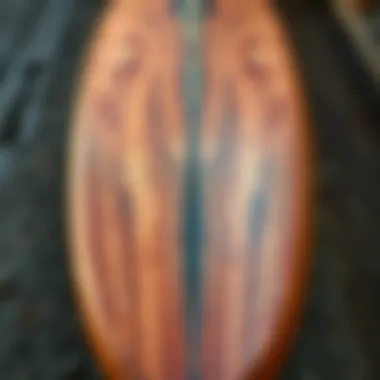
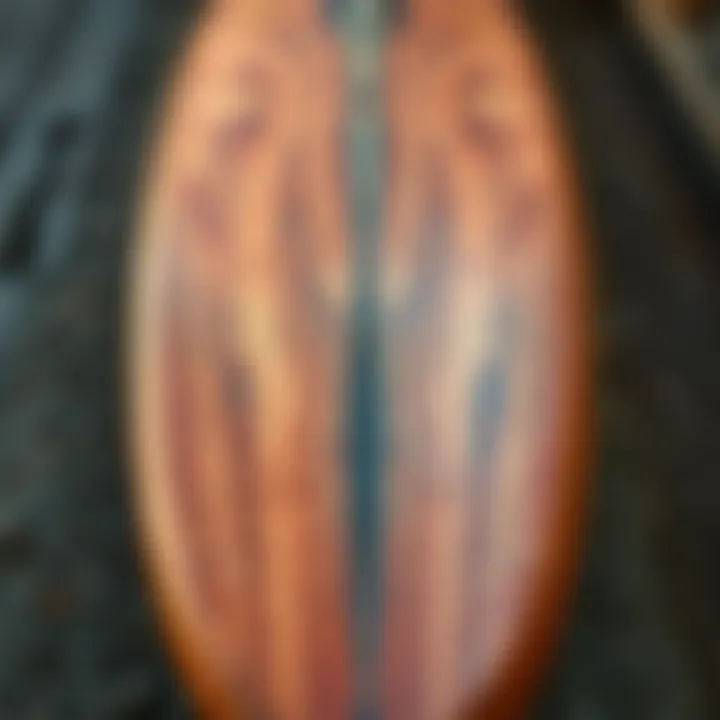
Intro
The world of surfboarding is not just about waves and maneuvers; it’s also about the equipment that enhances performance and enriches the surfing experience. The teak tuning decks hold a critical place within this dynamic environment. When crafted adeptly, these decks can elevate the performance of surfboards while also providing aesthetic charm. But what exactly makes teak wood so appealing for this purpose?
Teak is renowned for its durability and resistance to the challenges posed by the ocean. It doesn't warp easily, stands up to moisture, and has an attractive grain that attracts many surfers. In this guide, we will venture into the realm of teak tuning decks. We'll discuss their unique properties, the craftsmanship behind them, and their clear benefits, not just to the surfers but also to the environment.
Diving into deeper waters, we will also consider innovations in surfboard technology, which are shaping the future of surfing gear. It’s worth noting that the craft of sustainable surfing is evolving too. Enthusiasts are increasingly interested in eco-friendly materials. Beyond that, we will touch on the skills needed to ride the waves effectively while ensuring your deck is tuned to perfection.
Stay tuned as we navigate through the intricate details of teak tuning decks, and let’s get ready for a comprehensive ride through the surf culture.
Prelims to Teak Tuning Decks
In the expansive and vibrant world of surfing, enthusiasts always seek the best tools and accessories that can elevate their experience. Among these crucial elements is the teak tuning deck, a component that not only enhances functionality but also adds an aesthetic dimension to surfboards. Understanding teak tuning decks is vital for surfers, whether they're seasoned veterans or just starting their journey. This section will unravel the significance of teak tuning decks, exploring how they enhance performance and provide unique characteristics that can redefine how one rides the waves.
Defining Teak Tuning Decks
Teak tuning decks are specific enhancements made to surfboards, often crafted from the high-quality wood known as teak. Known for its durability and resistance to the elements, teak wood is a popular choice among builders aiming for longevity and performance. These tuning decks often sit on the top surface of the board, providing a comfortable and secure footing for the surfer.
They are not merely an addition; they significantly impact the surfer’s connection to the board. When standing on a tuning deck, a surfer is able to make fine adjustments to their stance and balance. This is crucial when riding waves, as every shift in weight can alter the surfboard's dynamics dramatically. A proper teak tuning deck ensures that responses are swift and accuracy is maintained, granting surfers more control as they navigate through challenging waters.
Historical Context of Tuning Decks in Surfboarding
The journey of tuning decks traces back several decades. In the early days of surfboarding, surfers primarily focused on the shape and design of the board itself. Over time, it became apparent that the deck’s material and surface could greatly affect performance. Wood was a prevalent choice, not just for its natural beauty but also due to its resilience and grip.
However, as synthetic materials entered the scene, many began to overlook wood’s benefits. Initially, plastic and fiberglass seemed to offer simpler solutions and lower prices. Yet, amidst the synthetic boom, a resurgence in traditional materials emerged, particularly teak. Surfers started recognizing that the tactile feel of wood underfoot provided a unique experience that synthetic materials could not emulate. Thus began the renaissance of teak tuning decks, marrying craftsmanship with modern surfing demands. Today, almost all high-end surfboards offer an option for teak tuning decks, making it a common sight on the waves.
Properties of Teak Wood
The use of teak wood in tuning decks for surfboards is a conversation that often piques interest among surfers and outdoor enthusiasts alike. It’s not just about aesthetics or traditional craftsmanship; it’s about what makes teak stand out in terms of functionality, longevity, and overall experience on the waves. Teak, recognized for its unique properties, features prominently in surfboard construction, particularly in the tuning decks that enhance performance.
Durability and Resistance to Water
One of the most significant selling points of teak wood is its durability. This material can withstand the wear and tear from saltwater, sun exposure, and the constant pounding from waves. Unlike many other woods that can warp, crack, or rot after prolonged exposure to moisture, teak holds its ground, remaining solid and reliable over time. This trait stems from the natural oils present in teak, which act as a repellent against water.
Surfers who spend long days in the ocean must consider how their equipment will hold up. With teak, the longevity translates into fewer worries about maintenance and replacement. A well-kept teak deck can easily last for many seasons, surviving both the rigors of choppy waters and the harsh sun beating down during summer surfing sessions.
"Choosing teak for my board was a game changer. I've had it for years, and it's like it just gets better with time!"
– An avid surfer's insight
Another factor supporting teak’s durability is its inherent density. This quality allows for better impact resistance, meaning that minor knocks and drops during transport or while catching that perfect wave won’t leave permanent damage. It gives surfers the confidence to push their performance limits, knowing their gear isn't going to fail them unexpectedly.
Aesthetic Qualities of Teak
Beyond its tough-as-nails reputation, teak is also celebrated for its aesthetic charm. The warm, golden hues of teak wood bring a rich, natural beauty that is hard to overlook. This warm tone not only adds a touch of elegance to the surfboard, but it also pairs effortlessly with a variety of designs and colors, allowing surfers to express their individual style on the waves.
Moreover, the richness of teak can fade into deeper colors, aging beautifully much like a fine wine. This natural evolution is attractive to many, emphasizing a connection to nature that synthetic materials simply can’t replicate. Even as it ages, that distinctive look maintains a unique character that draws the eyes of fellow surfers.
When stepping onto a teak tuning deck, there is this immediate sense of luxury and quality. The texture of teak is also tactile; its smooth finish juxtaposed with the grain patterns provides both functionality and an aesthetic pleasure.
A few notable characteristics highlight the aesthetic appeal:
- Variations in Grain Patterns: Each piece of teak is distinctly different, making every board with a teak deck unique.
- Natural Resistance to Fading: Teak retains its visual appeal without the need for extensive treatments, unlike some other woods.
The Role of Tuning in Surfboard Performance
Tuning a surfboard is no trivial affair. It’s the fine-tuning that can make a significant difference in how a board interacts with water. Each surfboard is like a finely-tuned instrument; when it's well-tuned, it can behave in ways that can enhance a surfer’s performance on the waves. Tuning not only affects the maneuverability and speed but also adjusts how responsive a board is to the surfer's movements. In this section, we’ll decipher how the art and science of tuning influence surfboard performance and dive into the specifics that make teak tuning decks stand out.
Understanding Surfboard Dynamics
To appreciate how tuning works, it's essential to grasp the basic dynamics of a surfboard. Generally, when a surfer paddles out, they want their board to glide smoothly over the water. This involves understanding several elements: the hull shape, the rocker profile, and the fin setup. Each of these components contributes to how the board performs.
- Hull Shape: A board's hull can be pointed, round, or something in between. A pointed hull usually means better speed for cutting through water, while a rounder hull offers stability.
- Rocker Profile: This is the curve of the board from nose to tail. A more pronounced rocker provides better maneuverability for tight turns but can sacrifice speed.
- Fin Setup: The number, type, and placement of fins can radically alter performance. More fins might mean increased stability, while fewer fins can result in more freedom during turns.
These dynamics work together in a symbiotic relationship, and tuning is about maximizing each aspect depending on conditions and personal preferences. This is where teak tuning decks shine, as they can be tailored with precision to enhance these dynamics.
How Teak Enhances Tuning Capabilities


Teak wood is often hailed not just for its aesthetic qualities, but for its innate properties that are beneficial for surfboards. When it comes to tuning decks, its weight-to-strength ratio is a significant advantage. A well-crafted teak tuning deck can ensure that the board retains a superior balance of weight and durability.
- Weight Distribution: Teak’s density allows for optimal weight distribution. When a tuning deck is precisely cut and fitted, it can help in controlling how the board sits in the water.
- Durability: Surfboards face harsh conditions. Teak wood’s natural oils help resist moisture and prevent warping, thus maintaining the integrity of the tuning even after multiple encounters with the ocean's waves.
- Shock Absorption: The fibrous quality of teak wood contributes to better shock absorption during impacts, which is crucial when performing tricks or riding massive waves.
"The right tuning deck isn’t just about aesthetics; it's about making a statement on the water. A well-tuned board can turn the tide of performance in any surfer's favor."
Craftsmanship of Teak Tuning Decks
The craftsmanship involved in creating teak tuning decks is a hallmark of quality and attention to detail in the surfboard industry. When a surfer steps onto their board, they expect not just performance but also a degree of artistry that reflects personal style and functionality. Teak wood, with its unique properties, lends itself beautifully to this type of craftsmanship. Experienced craftsmen know that their dedication to precision can make a world of difference in how a surfboard rides the waves.
Handcrafted teak tuning decks carry an air of authenticity and individuality, often showcasing the skill and creativity of the artisan behind the work. The subtle variations in the grain of the wood and the finish can tell a story about the environment from which the teak was sourced, as well as the personal touch of the creator’s hands. Each deck, shaped and finished with care, becomes a functional work of art.
Handcrafting vs. Mass Production
In the debate between handcrafting and mass production, enthusiasts often lean towards the former, appreciating the level of care that goes into each piece. Handcrafted tuning decks are typically made by skilled artisans who understand every curve and angle necessary for optimal performance. These craftsmen might spend hours ensuring that every detail is accounted for.
On the flip side, mass-produced decks promise affordability and availability, aiming to cater to a wider market. However, these decks may lack the nuanced touch found in hand-crafted pieces. In some instances, mass production can lead to variations in quality and performance, as uniformity tends to overshadow uniqueness.
- Benefits of Handcrafted Decks:
- Benefits of Mass-Produced Decks:
- Individual attention to detail
- Unique aesthetic characteristics
- Higher performance levels due to personalized tuning
- Cost-effectiveness
- Availability at various retailers
- Consistent design and production process
Finding the right balance between these two approaches often depends on the surfer’s personal preferences and budget. Ultimately, craftsmanship remains a key element in evaluating which teak deck suits an individual’s surfing style and intentions.
Techniques in Fitting and Finishing
When it comes to fitting and finishing teak tuning decks, various techniques can help elevate a board from functional to extraordinary. One fundamental method is the lamination process, which involves layering thin sheets of teak wood to enhance durability and create the desired flex. This layered approach not only improves performance but also adds an aesthetic appeal that is eye-catching.
Another vital technique is the sanding and sealing process. Craftsmen pay close attention to achieving a silky-smooth finish, essential for easy navigation on the board. They utilize different grades of sandpaper and sealing compounds crafted specifically for teak wood, allowing the natural oils present in the wood to shine through while protecting it against the elements.
- Common Techniques for Fitting and Finishing:
- Lamination: Enhances strength and flex
- Sanding: Aids in a smooth, user-friendly surface
- Sealing: Protects wood while showcasing its beauty
"The beauty of a finely crafted teak deck is not just in its appearance, but also in its performance on the waves."
Ultimately, the craftsmanship of teak tuning decks involves not just skill but also a deep understanding of the material's properties and the surfer's needs. Whether opting for hand-crafted or mass-produced options, it's essential to appreciate the intricacies involved in making a quality surfboard that promises both fun and performance.
Maintenance of Teak Tuning Decks
When you invest in teak tuning decks for surfboards, maintenance becomes paramount. It doesn't simply prolong the life of the deck but also enhances its aesthetic charm and functional performance. Teak wood, celebrated for its robustness, still requires care to stave off the inevitable wear and tear. Similar to a car needing regular oil changes, your teak deck needs specific attention to remain in top shape.
Cleaning and Care Practices
Regular cleaning is the bedrock of maintaining teak tuning decks. Saltwater, sand, and debris can conspire to dull the surface and compromise its integrity over time. Here are some practical steps you can follow:
- Rinse with Fresh Water: After a day of surfing, give the deck a good rinse with fresh water. This simple habit helps remove salt residue and prevents buildup that could lead to corrosion.
- Use a Soft Brush: Every so often, a thorough clean will do wonders. A soft brush, paired with a mild soap solution, can help eliminate stubborn stains. Just make sure to go with the grain—this avoids scratches.
- Dry Properly: After rinsing or cleaning, dry the deck with a soft cloth. Leaving it wet can cause mildew or fading over time.
Maintaining the bond between functionality and visuals is critical, and using the right products can help. Avoiding harsh chemicals is essential; they can strip away the natural oils that make teak durable. Instead, look for biodegradable products that are gentle yet effective.
"A well-cared-for teak deck is like a fine wine; it only gets better with time."
Long-Term Preservation Techniques
Taking the long view in teak preservation involves a few more nuanced methods. Here’s what you can do:
- Applying Teak Oil: Every six to twelve months, consider applying teak oil to your deck. This enhances the wood’s natural sheen, keeping it looking rich and vibrant while also offering protection against the elements.
- Storing Properly: If you’re not going to surf for a while, store your board in a dry, shaded area. Sunlight can lead to fading while moisture can encourage mold. Using padded bags can also shield the deck from accidental damage.
- Regular Inspections: Just like checking your surfboard’s fins or leashes, make a habit of inspecting the deck periodically. Look for signs of wear, loose fittings, or even discoloration—catching these issues early can save a lot of hassle down the line.
- Note: Application should be done on a dry surface, during conditions that aren’t too humid.
Keeping these practices in mind, your teak tuning deck will not just survive but thrive. Embracing the responsible care of your deck illustrates respect both for your craft and for the material itself. Engaged surfers often find that well-maintained gear significantly enhances their performance.
In essence, a little TLC goes a long way.
Resources for Further Reading:
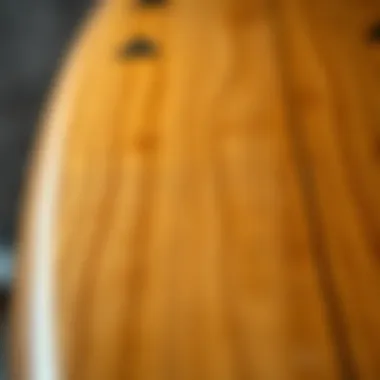

- Wikipedia on Teak Wood
- National Oceanic and Atmospheric Administration's Guide to Marine Environment
- Surfer Magazine: Maintenance Tips
Environmental Considerations
As surfers and outdoor enthusiasts, it’s important to keep our impact on the environment in mind. When discussing teak tuning decks, we delve into not only the craftsmanship and aesthetics they bring to surfboards but also crucial ecological aspects. Understanding environmental considerations allows us to make informed choices that can benefit both our surf experiences and our planet. The demand for materials in surfboarding shouldn't come at the expense of our forests or marine life, and here is where sustainable practices come in.
Sourcing Sustainable Teak
Sourcing sustainable teak is becoming more important than ever. Traditional teak, prized for its durability and resistance to water, often comes from rainforests where deforestation is rampant. Choosing teak from sustainably managed sources helps to alleviate some of this environmental stress. Sustainable harvesting practices, such as selective logging, ensure that forests remain healthy and biodiversity is preserved.
Many companies now offer teak that has been certified by organizations like the Forest Stewardship Council (FSC). This certification assures that the teak is harvested in a responsible way. For surfers looking to purchase a board with teak tuning decks, it’s vital to check for these certifications. Every decision counts, and when you choose sustainable teak, you not only get quality but also contribute to environmental protection.
"Sustainable sourcing isn’t just a buzzword; it’s our ticket to ensuring beautiful surf spots remain untouched for future generations."
As you contemplate your next surfboard with teak tuning decks, consider supporting brands that prioritize sustainable practices. This choice ensures you're not just enjoying waves today but also safeguarding the environment for the surfers of tomorrow.
Impact of Teak Production on Forest Ecosystems
The production of teak has profound effects on forest ecosystems. Unsustainable logging practices can lead to habitat destruction and loss of biodiversity. Forests are not just home to trees but are vital ecosystems that support countless species, including birds, mammals, and insects. When these ecosystems are disrupted, it can take decades, if not centuries, for them to recover. This highlights the importance of responsible teak cultivation.
Teak trees have deep root systems which help prevent soil erosion and maintain the health of surrounding flora and fauna. By disrupting these trees through unchecked logging, we risk destabilizing entire ecosystems. Sustainable teak farms often prioritize replanting, which helps to maintain the forest's integrity and resilience.
Additionally, the local communities that depend on forest resources face challenges when production methods are harmful. When logging is done hastily, these communities can suffer economically and culturally. By advocating for responsible teak utilization, we contribute not only to stronger ecosystems but also to the welfare of those living near these forests.
In summary, when considering teak tuning decks for surfboards, one must look beyond the product itself. Understanding its environmental impact helps safeguard the very essence of our surf culture and Mother Nature's beautiful landscapes.
User Experiences with Teak Tuning Decks
When it comes to surfboards, the connection between rider and board can often be the difference between gliding smoothly on a wave or wiping out spectacularly. User experiences with teak tuning decks amplify this understanding. Feedback from surfers highlights a tapestry of stories reflecting on performance, comfort, and overall satisfaction. Understanding these personal accounts is important for anyone considering teak tuning decks, as it showcases how these elements can enhance not just the stability and agility of a surfboard, but also the emotional connection to the sport.
One of the standout attributes of teak tuning decks, according to veteran surfers, is their tactile warmth compared to synthetic materials. Many find that the resonant feel underfoot translates to a more responsive ride. As Jerry, a surfer with over 15 years of experience, shared:
"With teak, it’s like you’re hugging the ocean. The grip keeps my confidence high, especially in gnarly conditions."
This sentiment underlines the importance of user feedback; the tactile quality of teak wood can bolster a surfer's performance by boosting their self-assurance out on the waves.
Furthermore, the long-term reliability that teak offers has earned accolades among surf enthusiasts. Comments about its resistance to wear and tear often surface in discussions. The solidity of teak tuning decks ensures that surfers experience minimal degradation, even after dozens of outings. As Kyle points out:
"I had a cheap board with a plastic deck last season; every session felt less alive. Switching to teak, it feels like I'm on a whole different level. Not only is it durable, but the aesthetics just make it more enjoyable to ride."
In essence, user experiences reflect both emotional and practical benefits. Surfers look for a blend of functionality and a sense of artistry in their gear. Teak tuning decks provide an experience that bridges this gap well.
Testimonials from Experienced Surfers
Diving into testimonials reveals a mosaic of reactions that frame the conversation around teak tuning decks. Many seasoned surfers emphasize the fusion of tradition and modernity these decks represent. Their tales often echo the universal resonates that surround personal evolution in the sport. These narratives go beyond superficial satisfaction; they suggest a deeper resonance with the materials shaping the surfing journey.
For instance, Alex, a competitive surfer known for his challenging stunt performances, shared:
"Teak isn’t just material; it speaks in waves. Every carving, every turn feels more intentional, more in tune with what the ocean is offering."
This eye-opener showcases how user engagement with teak translates into an almost spiritual connection with both the surfboard and the ocean.
Moreover, many talk about shared camaraderie, with stories of weekend trips where teak tuning decks are a talking point among friends. Several describe how they enjoy exchanging personal insights, resulting in collective appreciation for the craftsmanship behind these decks. These informal interactions foster a sense of community around surfing, making teak not just a choice of material but a badge of honor.
Comparative Experiences with Other Materials
In the quest for the right surfboard, comparisons inevitably arise between various materials used in tuning decks. While many enthusiasts have opted for alternative options, the unique properties of teak regularly resurface in dialogues as a more favorable choice.
Weight and Balance: The heft of teak compared to lightweight alternatives like foam or synthetic materials is often debated. Surfers argue that although comparable in weight, the balance and distribution of force during a ride feels distinctively better with teak. Surfers adept at maneuvering through high-energy waves often report increased control when using teak tuning decks.
Durability vs. Performance: Synthetic decks may offer higher resistance in terms of scrapes and impacts, but seasoned riders frequently note that this durability comes at a cost to performance. Typical accounts note a loss of sensitivity to wave movements that teak decks seemingly keep alive. A balanced mixture of sturdiness and feedback grants an edge to teak in the eyes of some devoted surfers. This isn�’t just about riding a board; it's about anticipating the ocean's rhythm.
Cost-Effectiveness: The price point of teak relative to cheaper plastics can seem daunting. However, surfers often argue that investing in a teak deck translates to long-term savings and satisfaction. Many believe that a well-maintained teak tuning deck that delivers consistent performance can outweigh the upfront costs.
With both sides presenting valid points, user experiences with teak tuning decks highlight a preference that often leans towards deeper connections and richer surfing experiences. Ultimately, it’s a choice that reflects not just an affinity for materials, but a dedication to the artistry of surfing.
Future Trends in Surfboard Tuning Technology
The landscape of surfboarding continues to evolve, and so too does the technology behind it, particularly concerning teak tuning decks. Understanding the future trends in surfboard tuning isn't merely an academic pursuit—it can be the very difference between a lackluster ride and one that feels like gliding over glassy waves.
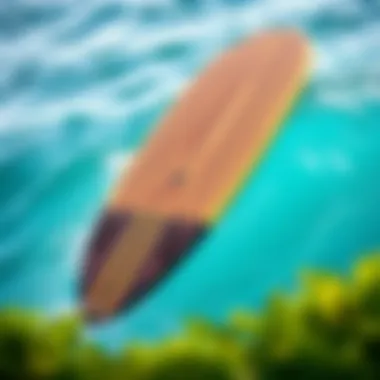
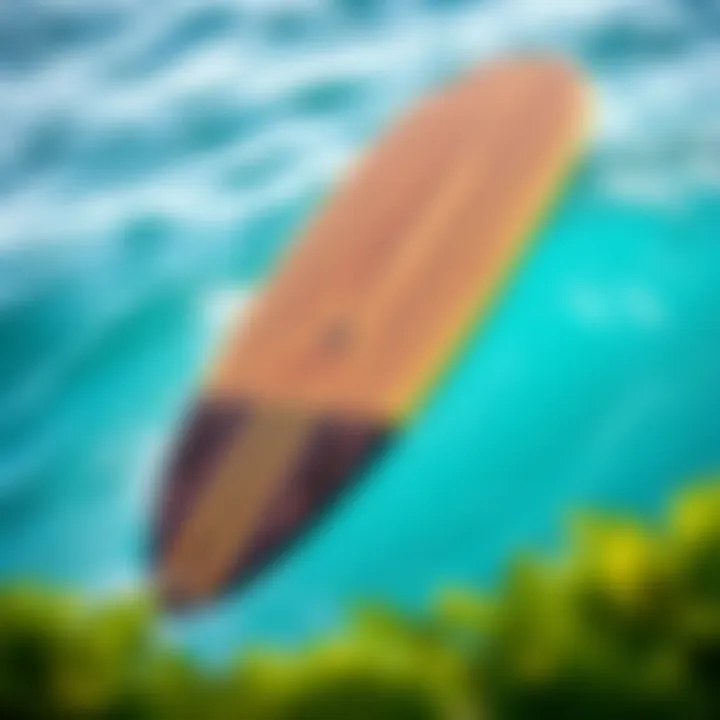
As surfers become increasingly specific in their needs, manufacturers will pivot to more sophisticated materials and designs. Moving forward, we will see several key trends that could redefine expectations in tuning decks:
- Customized Fits: Tailored solutions for individual surfers, from professional to novice. Expect styling and sizing that considers everything from foot shape to personal riding style.
- Eco-Conscious Innovations: As sustainability takes root in manufacturing, we could see advancements in materials that uphold the performance expectations of traditional teak while being kind to Mother Earth.
- Nanotechnology: Imagine coatings that enhance performance by repelling water or optimizing grip under varied conditions. This isn't science fiction; it could soon be a reality for tuning decks.
Future trends won't just improve performance; they promise to reshape the very fabric of surf culture.
Innovations in Materials and Design
As surfers demand more versatility and performance from their gear, manufacturers are responding with cutting-edge materials. Beyond traditional teak, expect to see composite materials that combine the benefits of teak with lighter, synthetic options. These innovations are pivotal because they improve performance metrics like buoyancy, durability, and responsiveness.
- Bio-Resins and Composites: Using bio-resins derived from renewable resources paired with synthetic materials to maintain durability while promoting sustainability. This combo is gaining traction.
- 3D Printing: You heard that right. With the rise of 3D printing technology, customized parts for tuning decks could soon be produced on-demand, eliminating wait times and waste.
- Advanced Anti-Slip Treatments: New surface treatments that promise better grip can help eliminate accidents when you’re riding the waves, ensuring that your feet stay planted where they should be.
A shift towards these materials signifies not just a change in the product but a holistic shift in how surfers view the relationship between man, machine, and the ocean.
Integration of Technology in Surfboard Design
Gone are the days when surfboards were merely wood and foam. Now, it's not uncommon to find boards embedded with sensors that collect data about performance metrics during each wave. This tech infusion may sound a bit over the top, but the benefits are tangible. Here’s where researchers and companies see potential:
- Performance Tracking: Boards equipped with technology to gather data can help surfers analyze their performance in real-time. Users could view insights on their rides right on their smartphone, allowing for immediate adjustments in technique.
- Smart Coatings: With advancements in material science, boards can feature smart coatings that adapt to wave conditions, optimizing buoyancy and reducing drag accordingly. Imagine equipment that reacts in the moment to improve your ride.
- Interactive Design Software: Future advancements might lead to software programs that allow surfers to simulate different board configurations before making a purchase, ensuring they get their ideal setup based on personal metrics.
These technology integrations aren't just for high-end boards. The aim is to democratize access to performance data, allowing surfers at all levels to benefit from these innovations.
Keeping an eye on these trends is crucial for any surfer looking to stay ahead of the game. By tuning into the future, surfers can better prepare themselves for a thrilling ride in the years to come.
Comparative Analysis: Teak Vs. Alternative Materials
When it comes to surfboard tuning decks, choosing the right material can feel like navigating through a minefield. On the one hand, you have teak—renowned for its durability and aesthetics. On the other, there’s a slew of alternative materials, each boasting unique properties. Understanding the nuances of these materials helps surfers make informed decisions tailored to their needs.
Weight and Performance Dynamics
Weight is a pivotal factor influencing surfboard performance. Teak, while slightly heavier than alternatives like fiberglass or carbon fiber, often brings a robustness that many surfers value while riding the waves. The essential property of teak lies not solely in its weight but in how it distributes that weight. A tuned deck of teak might feel more solid underfoot, which translates to greater stability while navigating choppy waters.
- Versatility in Wave Conditions: The added weight from teak can enhance a surfer’s ability to handle bigger waves. Surfers might favor the buoyant cushioning provided by hardwood over lighter materials when faced with rough surf.
- Weight Distribution: Teak’s density allows for better weight distribution across the board, which aids in maintaining speed during maneuvers. Unlike lighter materials that might warp or flex under stress, teak’s integrity helps in promoting a stable ride.
In contrast, alternatives like plastic composites or even bamboo may provide lightweight options, but they can compromise on stability—especially in dynamic environments. A surfer dealing with unpredictable wave action might find themselves favoring the predictability that comes with teak.
Cost Implications for Surfboard Enthusiasts
When talking about costs, it's essential to weigh the financial aspect against potential long-term benefits. Teak can be pricier initially, and this can deter some surfers. However, the correlation between initial investment and ongoing performance merits discussion.
- Initial Cost vs. Longevity: Teak tuning decks generally demand a higher price tag than alternatives, often due to the superior craftsmanship involved. However, if one considers the longevity and low maintenance of teak—especially in a saltwater environment—it may be wise to view it as an investment.
- Replacement Costs: Materials like foam or less durable woods may require frequent replacement, leading to higher annual costs over time. Choosing a teak tuning deck might mean fewer repairs or replacements, thus balancing out the initial outlay.
- Value Retention: Teak also retains its value well, especially for avid surfers who might resell equipment. Alternative materials often show wear and tear that detracts from their resale value over time, which isn’t typically the case for high-quality teak products.
All in all, while some surfers might lean towards cheaper alternatives for an initial buy, calculating the total cost of ownership in terms of performance, longevity and maintenance should be part of the decision-making process.
"Choosing the right material for your tuning deck isn’t just about aesthetics or enjoyment on the water; it’s about investing in your performance and future runs on the waves."
In the long-run, a well-informed choice could make all the difference between a fleeting experience and one that keeps calling you back to ride the swell.
Culmination and Final Thoughts
The surfboard industry has seen a significant evolution over the years, but one constant remains: the enduring value of teak tuning decks. This article has detailed how these decks impact performance, durability, and aesthetics. The distinctive properties of teak, including its resilience to water and appealing visual qualities, make it a prime choice for surfers aiming to enhance their riding experience. Moreover, understanding the craftsmanship behind these decks underscores their importance not just as mere accessories, but as essential components that contribute to overall surfboard dynamics.
It’s also essential to consider the environmental implications of sourcing teak wood. Sustainable practices in teak cultivation foster a healthier ecosystem, allowing surfers to engage with their passion while being mindful of the planet. This balance of enjoyment and responsibility adds depth to the surfing culture, reminding us of our connection to nature.
Moreover, user testimonials reveal a community that values these tuning decks for their ability to amplify performance and longevity. Similar to the equipment athletes use in various sports, a well-crafted teak tuning deck transforms a surfer’s interaction with the waves, making it a worthy investment.
In examining future trends, it’s clear that the integration of innovative materials and technologies will continue to shape the surfboard landscape. Findings in this article suggest surfers should stay diligent about new developments that can further optimize their versatility on the water.
In summary, teak tuning decks embody a combination of tradition and innovation, vital for both novice surfers and seasoned pros alike. This topic serves not only to educate, but also to inspire a deeper appreciation for the art and science behind surfboard design.
"Sustainable practices in teak cultivation foster a healthier ecosystem, allowing surfers to engage with their passion while being mindful of the planet."
Summarizing Key Insights
Throughout the exploration of teak tuning decks, several insights stand out:
- Durability: Teak wood remains resistant to harsh conditions, ensuring that your surfboard withstands the test of time.
- Craftsmanship: Handcrafted decks can provide a level of uniqueness and personalized performance that mass-produced options often lack.
- Environmental Responsibility: Emphasizing sustainable sourcing brings awareness to ecological concerns, ensuring future generations can also enjoy the surf.
- User Satisfaction: Collecting feedback has emphasized the positive impact of teak tuning decks on users’ experiences on the water, from enhanced performance to aesthetic satisfaction.
Looking Ahead to Future Innovations
As we glance into the future of surfboard technology, the landscape appears ripe for innovation. Upcoming trends may include:
- Hybrid Materials: The combination of teak with advanced composites could yield decks that are lighter yet retain essential properties of traditional wood.
- Smart Technologies: Developments in sensor technologies might allow surfers to collect performance data directly from their boards, transforming training sessions.
- Customizability: As demand for personalized gear increases, customization options for teak tuning decks that cater to individual styles and needs might become more prevalent.



